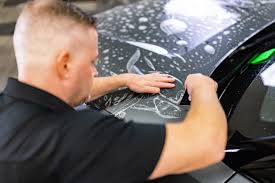Car window tinting is more than just a trendy upgrade—it’s a practical addition that provides a range of benefits, from protecting your vehicle’s interior to improving comfort and privacy. In this ultimate guide to car window tinting, we’ll explore everything you need to know, including the types of window tint, the benefits, legal considerations, and tips on how to maintain your tinted windows.
What is Car Window Tint?
Car window tint refers to a thin, transparent film applied to the windows of your vehicle. It’s designed to reduce the amount of light and heat that enters through the windows, while also offering privacy and protection from harmful UV rays. The tinting film is typically made of polyester and is available in a range of shades, from light to dark. Depending on the type of tint, the film may have additional features, such as heat rejection or UV-blocking capabilities.
Benefits of Car Window Tint
-
Heat Reduction and Comfort
One of the primary reasons people choose to tint their car windows is to reduce the amount of heat that enters the vehicle. Tinted windows can block out a significant amount of solar heat, making your car feel cooler, especially during the summer months. This not only improves comfort but can also reduce the need for air conditioning, leading to better fuel efficiency. -
UV Protection
UV rays from the sun can cause skin damage, premature aging, and even increase the risk of skin cancer. Window tint films, especially those that block UV rays, can block up to 99% of harmful ultraviolet radiation. This offers significant protection for both the vehicle’s passengers and the interior of the car, preventing the upholstery and dashboard from fading over time. -
Enhanced Privacy
Tinted windows offer a level of privacy that can make you feel more secure inside your vehicle. The darker the tint, the harder it is for people to see inside. This can be especially useful when driving in busy areas or when leaving valuable items in the car. The added privacy is also a deterrent for potential thieves, who are less likely to target a vehicle with visible valuables. -
Glare Reduction
Driving on sunny days can lead to glare, making it difficult to see the road. Window tinting helps reduce the amount of glare coming from both the sun and headlights from other vehicles. This can enhance visibility, reduce eye strain, and improve overall driving safety. -
Aesthetic Appeal
Beyond the practical benefits, tinted windows also enhance the appearance of your vehicle. The sleek, uniform look of tinted windows can make your car look more polished and sophisticated. It’s an upgrade that not only enhances functionality but also adds a touch of style to your ride.
Types of Car Window Tint
There are several types of car window tints available, each offering different features and benefits. Here’s a breakdown of the most common options:
-
Dyed Window Tint
Dyed tints are one of the most affordable options on the market. The tint is created by adding dye to the film, which absorbs sunlight and reduces heat. While they provide privacy and aesthetic appeal, dyed tints are less effective at blocking UV rays and heat compared to other types of tints. -
Metalized Window Tint
Metalized tints have a layer of metal particles that reflect light and heat. This type of tint is more effective at reducing glare and blocking UV rays than dyed films. However, they can interfere with electronic signals, such as GPS and radio reception, due to the presence of the metal layer. -
Ceramic Window Tint
Ceramic tints are made using ceramic particles, offering superior heat rejection, UV protection, and glare reduction. They are one of the most advanced and effective options available, providing excellent performance without interfering with electronic signals. While ceramic tints tend to be more expensive, their benefits in terms of performance and durability make them a worthwhile investment. -
Hybrid Window Tint
Hybrid tints combine elements of both dyed and metalized films, providing a balance of heat rejection, UV protection, and glare reduction. They offer better performance than dyed films while avoiding some of the signal interference issues of metalized tints.
Legal Considerations for Window Tinting
While window tinting offers numerous benefits, it is essential to note that there are regulations regarding the darkness of car windows. These laws vary by country and state or province, so it’s vital to be aware of the legal limits in your area before getting your windows tinted. Violating these laws can lead to fines and potential issues during vehicle inspections.
In many places, there are restrictions on the level of tint for the front windows and windshield. Generally, the rear windows and rear windshield are subject to more lenient regulations. Some jurisdictions also require a visible sticker or certificate to confirm that the tint meets legal standards.
Before getting your windows tinted, check with your local authorities to ensure you are complying with the law. A reputable tinting professional will be familiar with the local regulations and can advise you on the best tinting options that meet legal requirements.
How to Maintain Your Tinted Windows
To keep your tinted windows looking great and functioning correctly, it is essential to follow a few basic maintenance tips:
-
Avoid Cleaning the Windows Immediately After Tinting
After tinting your windows, it is essential to wait a few days before cleaning them. The adhesive used to apply the film needs time to cure, and cleaning the windows too soon can cause the tint to lift or bubble. -
Use the Right Cleaning Products
When cleaning tinted windows, avoid using abrasive cleaners or tools that can scratch the film. Stick to a soft cloth and non-ammonia-based cleaners to prevent damaging the tint. -
Keep the Windows Dry
Water can cause the tint to peel or bubble if it gets trapped between the film and the glass. Ensure that your windows are completely dry after washing or during periods of rain. -
Protect from Scratches
Be cautious of sharp objects or rough cleaning techniques that may scratch or damage the tint. Protect the tinted windows from any abrasions that could compromise their appearance or effectiveness.
Conclusion
Car window tinting is a valuable upgrade that offers a range of benefits, including improved comfort and privacy, as well as enhanced protection from the sun’s harmful rays. With a variety of tints available, including dyed, metalized, ceramic, and hybrid options, there’s something for every budget and need. However, it is crucial to stay informed about local regulations and choose a professional tinting service that adheres to legal guidelines. By maintaining your tinted windows properly, you can enjoy these benefits for years to come, enhancing your driving experience in both comfort and style.



